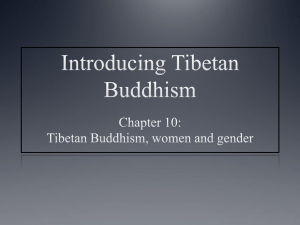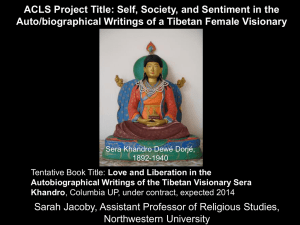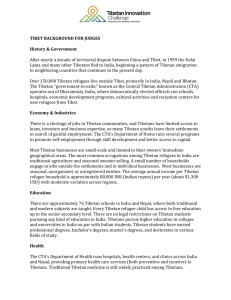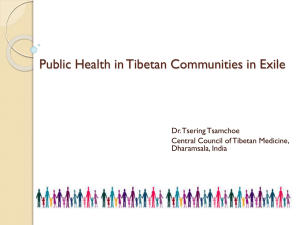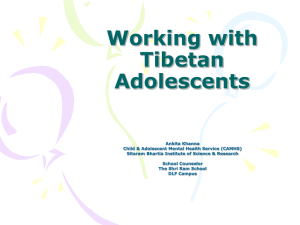Background on Tibetan Refugees
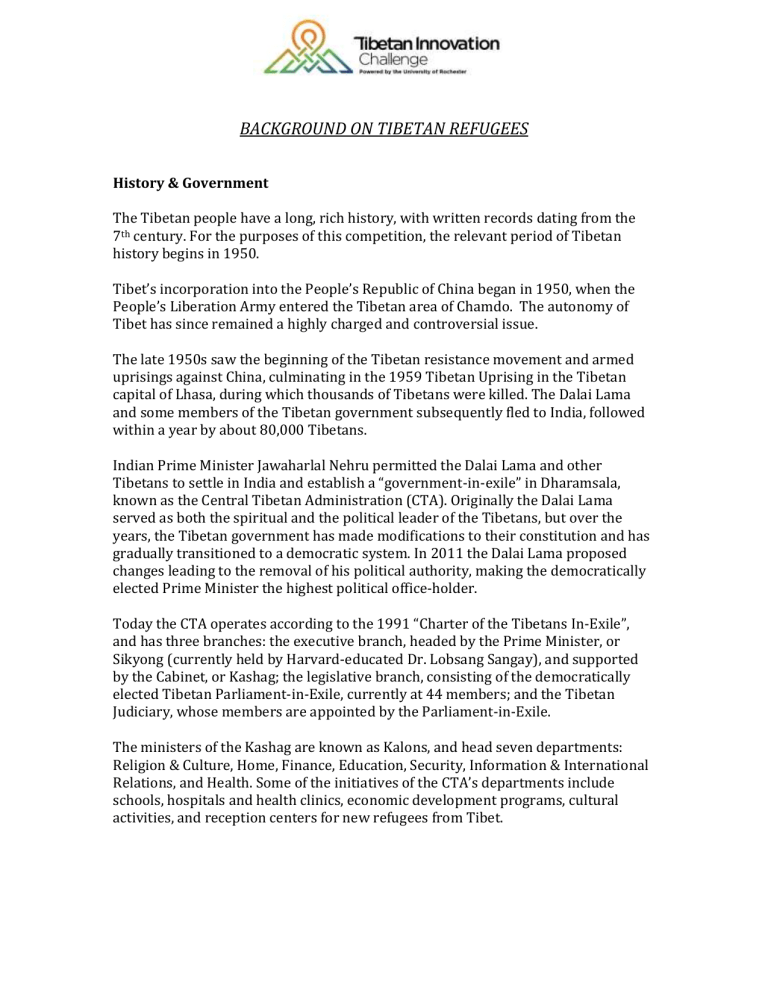
BACKGROUND ON TIBETAN REFUGEES
History & Government
The Tibetan people have a long, rich history, with written records dating from the
7 th century. For the purposes of this competition, the relevant period of Tibetan history begins in 1950.
Tibet’s incorporation into the People’s Republic of China began in 1950, when the
People’s Liberation Army entered the Tibetan area of Chamdo. The autonomy of
Tibet has since remained a highly charged and controversial issue.
The late 1950s saw the beginning of the Tibetan resistance movement and armed uprisings against China, culminating in the 1959 Tibetan Uprising in the Tibetan capital of Lhasa, during which thousands of Tibetans were killed. The Dalai Lama and some members of the Tibetan government subsequently fled to India, followed within a year by about 80,000 Tibetans.
Indian Prime Minister Jawaharlal Nehru permitted the Dalai Lama and other
Tibetans to settle in India and establish a “government-in-exile” in Dharamsala, known as the Central Tibetan Administration (CTA). Originally the Dalai Lama served as both the spiritual and the political leader of the Tibetans, but over the years, the Tibetan government has made modifications to their constitution and has gradually transitioned to a democratic system. In 2011 the Dalai Lama proposed changes leading to the removal of his political authority, making the democratically elected Prime Minister the highest political office-holder.
Today the CTA operates according to the 1991 “Charter of the Tibetans In-Exile”, and has three branches: the executive branch, headed by the Prime Minister, or
Sikyong (currently held by Harvard-educated Dr. Lobsang Sangay), and supported by the Cabinet, or Kashag; the legislative branch, consisting of the democratically elected Tibetan Parliament-in-Exile, currently at 44 members; and the Tibetan
Judiciary, whose members are appointed by the Parliament-in-Exile.
The ministers of the Kashag are known as Kalons, and head seven departments:
Religion & Culture, Home, Finance, Education, Security, Information & International
Relations, and Health. Some of the initiatives of the CTA’s departments include schools, hospitals and health clinics, economic development programs, cultural activities, and reception centers for new refugees from Tibet.
Demographics
Population: There are approximately 128,000 Tibetans living outside Tibet, primarily in India (94,203), Nepal (13,514) and Bhutan (1,298).
Age: More than half of all Tibetan refugees living in India, Nepal and Bhutan fall between the ages of 15 and 39. There are smaller but substantial populations of children under 15 and adults from 40-74. The population aged
75 years and older is relatively small.
Gender: The ratio of female Tibetan refugees to males is 798 per 1000.
Income: The average annual income per Tibetan refugee household is approximately 80,000 INR (Indian rupees) per year (about $1,300 USD) with moderate variation across regions.
Geographical Distribution
There are between 40-50 Tibetan settlements and scattered communities in India.
Although there are more settlements and communities in northern India, the total population of Tibetan refugees living there is about the same as in southern India.
The five most populated communities are marked in green on the map above. They are, from north to south:
Ladakh – 6,769
Dharamsala – 13, 701
Dekyiling – 5,686
Doeguling – 9,847
Lugsam – 9,229
Almost half (48%) of Tibetans in India live in these five communities.
Education
Education has been a top priority of the Dalai Lama and the Central Tibetan
Administration (CTA) in the refugee communities. Every Tibetan refugee child has access to free education up to the senior secondary level. There are no legal restrictions on Tibetan students pursuing any kind of education in India. The literacy rate of Tibetan refugees six years old and older is 82.4%, with the rate for males being higher than that for females (88.7% and 74.4% respectively).
There are about 76 Tibetan schools in India and Nepal run by various administrations, where both traditional and modern subjects are taught to Tibetan children. Many Tibetan families in China send their children to Tibetan schools in
India where students have more opportunity to learn the Tibetan language and to study Tibetan culture and history than they have in China. The CTA’s Department of
Education oversees all programs.
Tibetans pursue higher education in colleges and universities in India on par with
Indian students. Finances can be a prohibitive factor, but the CTA’s Department of
Education provides some scholarships to colleges and universities in India and abroad. Tibetan students have earned PhDs, master’s degrees, professional degrees and bachelor’s degrees in various fields of study.
Health
The CTA’s Department of Health runs 7 hospitals, 5 primary health centers, and 38 clinics across India and Nepal, providing primary health care services (both preventive and curative) to Tibetans in India. Services provided include TB control, mother and child health care (including prenatal services and immunizations), HIV medical support, health education, substance abuse prevention and rehabilitation, and disability support. Tibetans can receive more specialized secondary and tertiary care in Indian hospitals through the Tibetan Medical system, a subsidized welfare insurance system.
Congested living conditions, particularly in the schools and monasteries, have contributed to the rise of public health issues among Tibetan refugees. The worst of these are tuberculosis and Hepatitis B, both of which are prevalent at high rates in refugee communities. Tibetans also have seen an increase in chronic health conditions in recent years, such as diabetes, hypertension, cancer, and heart disease.
Traditional Tibetan medicine is still widely practiced among Tibetans, incorporating centuries-old traditions based on Buddhist principles alongside more modern
Western methods and treatments.
Economy and Industries
Most Tibetan businesses are small-scale with a rudimentary nature and focus, and are limited to their owners’ immediate geographical areas. The most common occupations among Tibetan refugees in India are traditional agriculture (46% of
Tibetan families practice farming or herding) and seasonal sweater selling (49% of families). 10% of households engage in jobs outside the settlements and in individual businesses, but most businesses are seasonal, unorganized, or unregistered entities. The average annual income per Tibetan refugee household is approximately 80,000 INR (Indian rupees) per year (about $1,300 USD) with moderate variation across regions.
There is a shortage of jobs in Tibetan communities, so many Tibetan youths leave their settlements in search of gainful employment. The Dalai Lama and the Tibetan government, concerned that the emigration of young people is diluting Tibetan culture and communities, are working to make it easier for young Tibetans to stay.
The Central Tibetan Administration (CTA) Department of Home runs several programs to promote self-employment through skill development and better access to capital. Examples include:
Youth Empowerment Support (YES) – provides job skill training and career services through several career centers
Institute for Small Trade Learning (ISTL) – a vocational training initiative run
by YES in Bangalore, India
Vocational training centers
Cooperative societies – organized into the Federation of Tibetan
Cooperatives in India Ltd.
Tibetans have very little or limited access to loans or investments for start-up capital or expansion, with a lack of connections to resources for financing and advisement. Tibetans in India also lack a supportive ecosystem for cultivating business ideas, including creative mitigation strategies addressing their refugee status and legal environment.
Tibetan refugees in India are unable to own land; however, federal and state governments in India have leased out thousands of acres of land for refugees to live in self-sufficient compact communities, where they may legally own and operate their own businesses.
Infrastructure
Tibetans are generally satisfied with available infrastructure in their communities; however, there are complaints in some areas. The most common complaints include:
Bad roads within settlements
Poor maintenance of housing
Absence of proper waste management system
Lighting in public spaces
Basic requirements in schools are satisfactory, but there is opportunity to improve technology-based teaching and learning aids, such as internet service, computerbased teaching, and Smartclass teaching.
Tibetan refugees in India are affected by some of India’s persistent infrastructural challenges and shortcomings, particularly limited or unreliable electricity services, water supplies, sanitation, and internet access. These services are especially underrepresented in rural areas.
Most of India’s power comes from coal; however, the government of India has indicated intentions to increase solar and hydroelectric power in the future.
Transportation
Access and proximity to transportation is better in the northern and southern settlements in India. The Tibetan settlements in northeastern India are more remote, making transportation and shipping difficult. Rural areas of India have poorer road conditions.
The government of India recently announced a new budget for 2015-16 in which infrastructural improvements to roads, railways, and ports are due to receive a sizable increase in funding.
Legal Considerations
For many years, the legal rights of Tibetan refugees in India weren’t clearly defined.
But in October 2014, not long after granting Tibetan refugees the right to vote in
Indian elections, the government of India approved the Tibetan Rehabilitation
Policy, which sets a uniform policy across all Indian states regarding the rights of
Tibetan refugees. In part, it specifies that Tibetans are allowed to undertake any economic activity, including starting enterprises, and are entitled to all associated permits and licenses. The policy states that Tibetans can pursue and take any jobs for which they are professionally qualified. It also extends the government’s land lease agreements with Tibetans.
Effectively there are no legal barriers to Tibetan refugees starting businesses in
India.
Land and Climate
Most of India has a tropical climate, although the mountainous northern and northeastern regions have a more alpine climate. Average annual temperatures across most of India are above 70° F (21° C). There are four seasons in India: winter
(January-February), summer (March-May), monsoon or rainy season (June-
September) and post-monsoon season (October-December). 80% of India’s precipitation falls during monsoon season. Droughts, floods, cyclones, and other natural disasters happen sporadically but can be severe.
The land and climate in the southern and eastern Tibetan settlements is more suitable for agriculture than in the northernmost settlements.
Social Atmosphere
Although relations are good between Tibetans and Indians, the two groups generally maintain their separate identities. Despite establishing settlements in
India over 50 years ago, most Tibetans still consider their residence in India temporary and look forward to a time when they can return home to Tibet (or, in the case of younger Tibetans born abroad, see Tibet for the first time). Most
Tibetans do not seek Indian citizenship or intermarry with Indians.
There are some generational differences among the social attitudes of Tibetans.
Many younger Tibetans were either born outside of Tibet, or left Tibet when they were very young, and thus have grown up under the influence of outside cultures.
Many Tibetan youth speak English, use the internet, enjoy western entertainment, and leave their communities in search of employment. The older generation of
Tibetans worries that their traditional culture is being diluted.
Political Atmosphere
The relationship between the CTA and the government of India is excellent.
Successive Indian governments have permitted the Dalai Lama to live in India since
1959, and the Indian government has allowed the CTA to operate schools, health
clinics, and other community amenities. Federal and state governments in India have leased out thousands of acres of land for refugees to live in self-sufficient compact communities, as well as for the establishment of monasteries to educate monks in Buddhism and Tibetan culture.
In 2014, the government of India granted Tibetan refugees the right to vote in
Indian elections, and also approved the Tibetan Rehabilitation Policy, which sets a uniform policy across all Indian states regarding the rights of Tibetan refugees. This policy has clarified, standardized, and extended the rights and benefits available to
Tibetan refugees in India.
Tibetan Culture
The geographical isolation imposed by the Himalayas allowed Tibetans, over a long period of time, to develop a unique culture separate from those of other peoples in central Asia. Tibetans have their own distinct language, art, music, dances, literature, architecture, cuisine, calendar, and cultural traditions. Tibetans both in
Tibet and in the rest of the world are committed to preserving the traditional elements of their culture. Much of Tibetan culture is influenced by Tibetans’
Buddhist beliefs; music, literature and artwork often feature religious themes.
In 1970, the Dalai Lama founded the Library of Tibetan Works and Archives in
Dharamsala, India to preserve and disseminate Tibetan culture. The library houses more than 110,000 manuscripts, books and documents, as well as photographs, artifacts, and works of art. Many of these cultural artifacts are religious in nature.
Importance of Religion
The sight of Tibetan Buddhist monks, in vivid crimson and golden robes, is familiar to people all over the world, as are the brightly colored strings of prayer flags commonly seen in the Himalayas. The overwhelming majority of Tibetans practice
Tibetan Buddhism, which is not so much a religion as a way of life for most Tibetans.
Although there are only an estimated 10-20 million followers of Tibetan Buddhism, the emigration of Tibetans to other parts of the world in recent decades has helped popularize Tibetan Buddhism throughout the globe.
Buddhism was introduced to Tibet in the 7 th century, and over time, Tibetans adapted it and made it their own, differentiating it from other schools of Buddhism by incorporating some elements of the Bon religion, a common folk religion in Tibet, and by the establishment of lamas, the title for their spiritual leaders. The most famous of these is of course the Dalai Lama, well known around the world today as the public face of Tibetan Buddhism.
The Dalai Lama is believed to be the manifestation of a bodhisattva, or enlightened being, who has postponed his own nirvana in favor of reincarnating to serve humanity. Tenzin Gyatso is the 14 th and current Dalai Lama. For several centuries, successive Dalai Lamas served as both the spiritual and political leaders of the
Tibetan people, until 2011 when the 14th Dalai Lama initiated a process of transferring his political authority to the democratically elected Sikyong, or prime minister, of the Tibetan Government-in-Exile.
The government of India has allowed Tibetan refugees to establish Buddhist monasteries to educate monks in Buddhism and Tibetan culture. As a result Tibetan
Buddhism continues to thrive among the Tibetan people.
